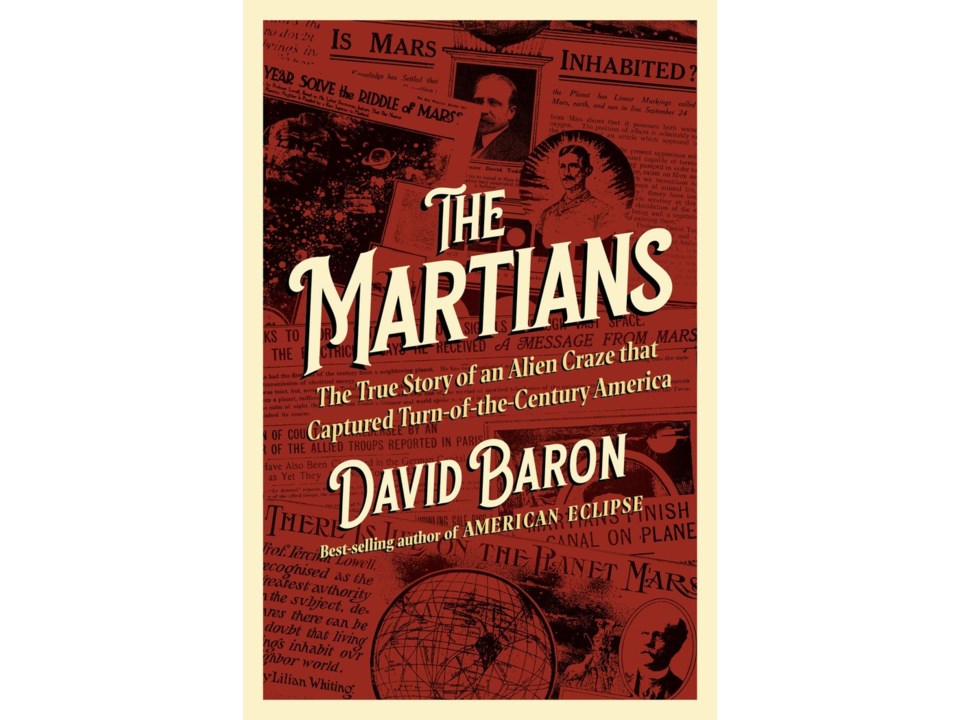Talk about fake news: In 1907 a New York Times banner headline declared, “There Is Life On the Planet Mars.” Upping the ante the next year, the stodgy Wall Street Journal claimed “proof” of “conscious, intelligent human life” on our red neighbor.
A decades-long cultural phenomenon is revisited in the “The Martians: The True Story of an Alien Craze That Captured Turn-of-the Century America” by science writer David Baron. He explores how a society on the cusp of reality-piercing scientific advances — global radio communications, X-rays, Einstein’s Theory of Special Relativity among them — bought into what in hindsight seems downright silly.
The idea of life on other planets had been orbiting the public imagination ever since the realization that the Earth wasn’t alone in the solar system. As Baron explains, advances in telescopes provided breakthrough views of an alien landscape that led to unbridled theorizing in extraterrestrial life, even civilization, all sparked by an innocent mistranslation.
While several astronomers in the late 19th century had observed the large patches of different colors and shades on our closest heavenly neighbor, Italian Giovanni Schiaparelli published them on a map. Projecting Earth-like characteristics, he connected Mars’ larger, darker areas thought to be oceans, with thin, linear features he labeled “canali,” Italian for “channels.” Misreported in English as artificial waterways, “CANALS ON THE PLANET MARS” headlined The Times of London in 1882.
From there, Baron tells a compelling story in which mankind’s greatest power, compelling storytelling, unleashes a tenuous scientific observation that drives premature speculation, and a thin veneer of logic spawns runaway flights of fancy. Incomprehensible experiments and complex mathematics — boring! — unlocked the secrets of the atom. But the “Mars craze” hooked popular culture with an exciting and understandable narrative. Given someone must have constructed those canals, are Martians folks like us?
No one was more spellbound than a Boston Brahmin armed with a Gilded Age fortune, Percival Lowell. Following a distinguished stint as a diplomat in the Far East, Lowell devoured the emerging Mars debate in print in the early 1890s. Dedicating his life and resources to further study of the nearby planet, the 39-year-old travelled to Flagstaff in the Arizona territory — the elevation and dry climate improved telescopic performance for the namesake observatory he financed — to spend countless nights peering at the cosmos.
Over the following years, Lowell did more than anyone to gather what he claimed was visible evidence of engineering on Mars. Though an amateur scientist, he deployed his Harvard erudition to write well-received books and deliver sold-out lectures, all to broaden the acceptance of the canal theory and the possibilities it opened. Most trained, reputable astronomers refused to speculate on the dark markings and did not think they held water – literally or figuratively. Where others were content to acknowledge a lack of reliable data, Lowell stated, “Imagination is the soul of science.”
It is the soul of science fiction as well. While many envisioned a hardy Martian society clinging to life thanks to massive public works projects, author H.G. Wells conjured aliens with “intellects vast and cool and unsympathetic, regarding this earth with envious eyes.” His 1897 classic, “The War of the Worlds,” brought the Martians across the void to his own London suburb where he gleefully imagined them “killing my neighbours in painful and eccentric ways.”
In Well’s climax, nature’s microbes decimated his Martians, but Baron deftly explains how human nature may have birthed them. Despite purportedly bigger and better sightings of the canals in 1907 — prompting the newspapers “of record” to finally accept Lowell’s claims — the scientific community eventually rallied to convince the public that the rectilinear structures he championed were merely optical illusions.
With the most honorable intentions, Schiaparelli, Lowell and their disciples subconsciously perceived Mars like a planet-size Rorschach test and thereby joined their ancient forebears who connected the dots in the night skies to create constellations animated with myths. When in 1971 the American spacecraft Mariner 9 photographed Mars’ first close-ups proving the absence of canals, sci-fi writer Arthur C. Clarke responded, “Whatever we can say about Lowell’s observational abilities, we cannot deny his propagandistic power.”
In “The Martians,” Baron captures the milieu spanning the ends of the Victorian and Edwardian eras without jeering at their lack of modern sensibilities. He leaves most opportunities for media criticism or parallels to today’s conspiracy theories to the reader, and judges Lowell gently by focusing on the many researchers and writers his works inspired. A later Mars enthusiast, author Ray Bradbury claimed, “There’s hardly a scientist or an astronaut I’ve met who wasn’t beholden to some romantic before him who led him to doing something in life.”
Or as Percival Lowell himself observed, “Ideas are as catching as scarlet fever.”
___
Douglass K. Daniel is the author of “Kill — Do Not Release: Censored Marine Corps Stories from World War II” (Fordham University Press).
___
AP book reviews: https://apnews.com/hub/book-reviews
Douglass K. Daniel, The Associated Press




